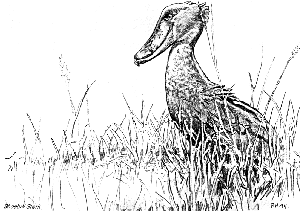In Search of a Latter Day Dodo
To the North of Zambia is a vast, watery wilderness known as the
We eventually arrived at the airstrip we were to have landed at, only to get the vehicle stuck in the swamp up to its axle. We abandoned it there, took off our shoes and socks, rolled up our trousers and paddled the 150 yards to a waiting boat. We had to do this about three times before we had transferred all our baggage. The going was comfortable to the feet as the grass was lung and soft and the water, nearly up to our knees, was warm. Once aboard, the boat had to be poled through channels between the sea of reeds and papyrus to an island which was where the camp had been established. This journey took about an hour. The island turned out to be a small patch of land a few inches above the surrounding water.
"Why all this effort to get here?" you are no doubt wondering.
Well, the
Next morning, the object of our visit was spotted, perched atop a small bush
on a nearby 'island'. It was off with shoes and socks again and we all set off
wading through the swamp. The 'nearby' island turned out to be an ambitious aim
and, after half an hours laborious effort, not getting
noticeably closer, we abandoned the idea. Instead, we packed some lunch and
returned to the 'mainland'. Here, there were thousands
of Black Lechwe to be seen scattered across the
plain, as far as the eye could see. These antelope are accompanied by there own
species of fly, in fact millions of them. Fortunately they did not bite humans.
One bonus of this little expedition was to see
 The
next day, a Shoebill was spotted again. This time we took a boat and made our
way by devious channels to get as close as we could without disturbing it. Over
a period of an hour or more, we completely lost track of time, our boatman
gradually manoeuvred the boat closer and closer, the
film manufacturers making a fortune by the minute. The last move proved one too
many and our bird flew off. But everyone was satisfied that we had achieved our
objective. The cost was high though (apart from the amount of film used) as we
all suffered masses of mosquito bites. Another 'hazard' around the camp was
ants. Returning to our tent in bare feet, I thought that I had trodden on a
thorn, only to find when I went to remove it from the sole of my foot that it
was a large black ant.
The
next day, a Shoebill was spotted again. This time we took a boat and made our
way by devious channels to get as close as we could without disturbing it. Over
a period of an hour or more, we completely lost track of time, our boatman
gradually manoeuvred the boat closer and closer, the
film manufacturers making a fortune by the minute. The last move proved one too
many and our bird flew off. But everyone was satisfied that we had achieved our
objective. The cost was high though (apart from the amount of film used) as we
all suffered masses of mosquito bites. Another 'hazard' around the camp was
ants. Returning to our tent in bare feet, I thought that I had trodden on a
thorn, only to find when I went to remove it from the sole of my foot that it
was a large black ant.
Regardless of all the discomforts, we considered our journey to the
For the Bird Watchers
Shoebill or Whale-headed Stork (Balaeniceps
rex) 150cm (59") Very large, dark grey, stork like bird with a huge,
pale, shoe-shaped bill and short tuft-like crest. Found in
For the Historians
The
For the Geographers
The